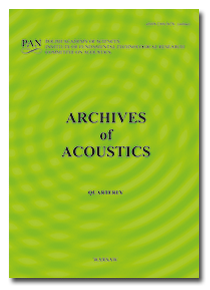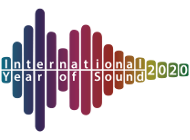Archives of Acoustics,
33, 4, pp. 565–571, 2008
Pulsed nonlinear acoustic fields from clinically relevant sources: numerical calculations and experiments results
The goal of this work was to verify experimentally the
applicability of the recently developed Time-Averaged Wave Envelope (TAWE)
method [1] as a tool for fast prediction of pulsed nonlinear pressure fields
from focused nonaxisymmetric acoustic sources in attenuating media. The
experiments were performed in water at the fundamental frequency of 2.8 MHz for
spherically focused (focal length F = 80 mm) square (20x20 mm) and rectangular
(10x25 mm) sources similar to those used in the design of 1D linear arrays
operating with ultrasonic imaging systems. The experimental results obtained
with 10-cycle tone bursts at three different excitation levels corresponding to
linear, moderately nonlinear and highly nonlinear propagation conditions (0.045,
0.225 and 0.45 MPa on-source pressure amplitude, respectively) were compared
with those yielded using the TAWE approach. Comparison of the experimental and
numerical calculations results has shown that the TAWE approach is well suited
to predict (to within [ampersand]plusmn;1 dB) both the spatial-temporal and
spatial-spectral pressure variations in the pulsed nonlinear acoustic beams.
applicability of the recently developed Time-Averaged Wave Envelope (TAWE)
method [1] as a tool for fast prediction of pulsed nonlinear pressure fields
from focused nonaxisymmetric acoustic sources in attenuating media. The
experiments were performed in water at the fundamental frequency of 2.8 MHz for
spherically focused (focal length F = 80 mm) square (20x20 mm) and rectangular
(10x25 mm) sources similar to those used in the design of 1D linear arrays
operating with ultrasonic imaging systems. The experimental results obtained
with 10-cycle tone bursts at three different excitation levels corresponding to
linear, moderately nonlinear and highly nonlinear propagation conditions (0.045,
0.225 and 0.45 MPa on-source pressure amplitude, respectively) were compared
with those yielded using the TAWE approach. Comparison of the experimental and
numerical calculations results has shown that the TAWE approach is well suited
to predict (to within [ampersand]plusmn;1 dB) both the spatial-temporal and
spatial-spectral pressure variations in the pulsed nonlinear acoustic beams.
Keywords:
rectangular focused apertures; pulsed acoustic fields; nonlinear
distortion; numerical modelling and experiments
Full Text:
PDF
Copyright © Polish Academy of Sciences & Institute of Fundamental Technological Research (IPPT PAN).





